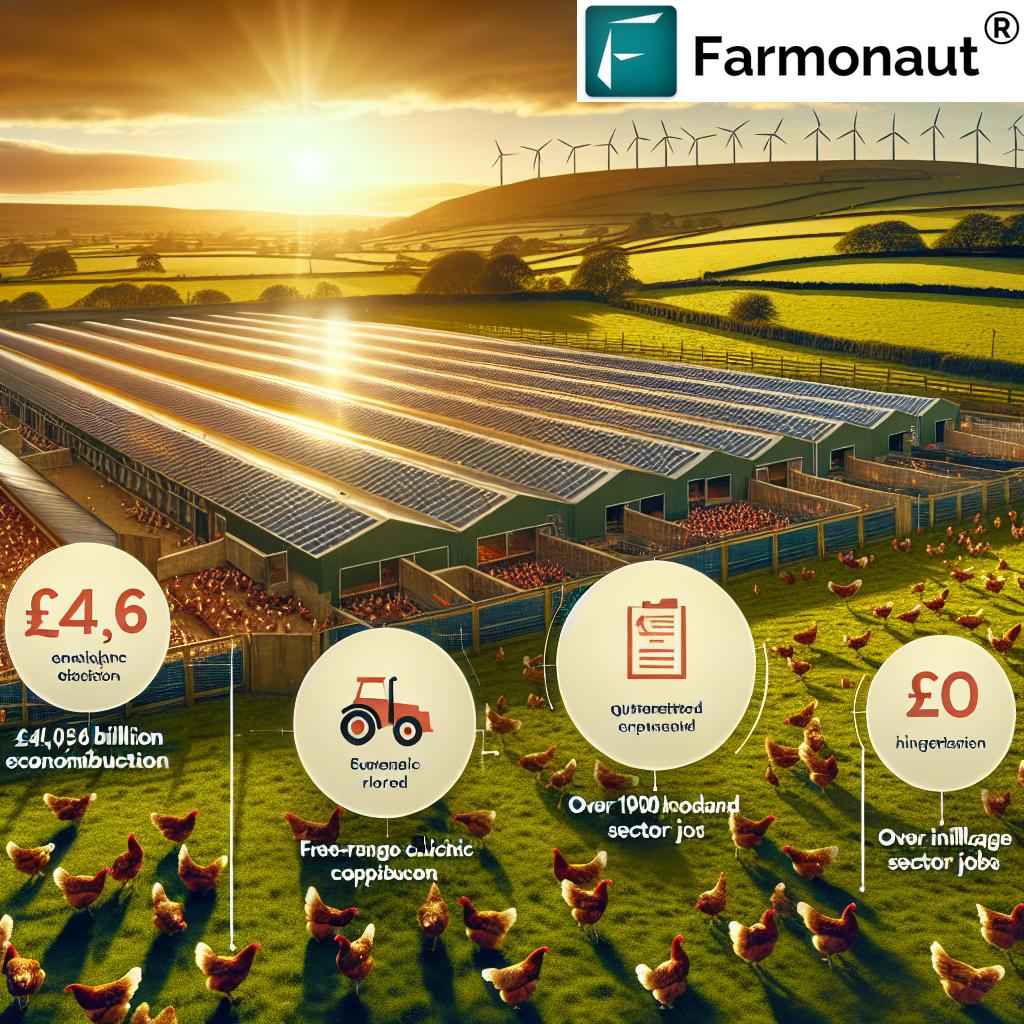Navigating England’s Coastal Access: Essential Guide for Landowners and Farmers
“England’s Coast Path spans approximately 2,795 miles, impacting numerous coastal farms and landowners.”
Welcome to our comprehensive guide on navigating England’s coastal access regulations. As representatives of Farmonaut, we understand the unique challenges faced by landowners and farmers in coastal areas. This guide aims to provide you with essential information and practical advice to help you manage your land effectively while complying with the latest coastal access regulations.
Understanding England’s Coastal Access Regulations
The introduction of new coastal access regulations in England has brought significant changes to the way landowners and farmers manage their properties along the coastline. These regulations, primarily stemming from the Marine and Coastal Access Act 2009, aim to improve public access to England’s coast while balancing the rights and responsibilities of landowners.
Key Aspects of Coastal Access Regulations
- Creation of the England Coast Path
- Establishment of coastal margins for public access
- Natural England’s role in proposing and implementing access routes
- Landowner rights and responsibilities
To help you navigate these complex regulations, we’ve created a comprehensive impact matrix:
| Regulatory Aspect | Key Changes | Landowner Responsibilities | Potential Challenges | Recommended Actions |
|---|---|---|---|---|
| England Coast Path Guidelines | Establishment of continuous walking route | Allow public access on designated paths | Balancing public access with farming operations | Review and understand path proposals |
| Natural England Proposals | Detailed plans for access routes and margins | Engage with consultation process | Potential impact on land use and privacy | Proactively participate in consultations |
| Agricultural Property Rights | Adjustments to accommodate public access | Maintain safety and manage liability risks | Protecting crops and livestock | Implement clear signage and fencing |
| Public Rights of Way | Integration with existing rights of way | Ensure paths are clear and accessible | Increased foot traffic and potential misuse | Regular maintenance and monitoring |
| Coastal Erosion Management | Considerations for changing coastlines | Adapt land management practices | Long-term viability of coastal farms | Develop erosion mitigation strategies |
| Agritech Solutions for Coastal Farms | Integration of technology in farm management | Adopt appropriate technological solutions | Initial investment and learning curve | Explore platforms like Farmonaut for efficient management |
Understanding these aspects is crucial for effective land management in coastal areas. Let’s delve deeper into each of these elements to provide you with a comprehensive understanding of your rights and responsibilities.
The England Coast Path: What Landowners Need to Know
The England Coast Path is a ambitious project aimed at creating a continuous walking route around England’s coastline. For landowners and farmers, this initiative brings both opportunities and challenges.
Key Points for Landowners:
- The path will follow existing rights of way where possible
- New sections may be created through private land
- Coastal margins will be established for public access
- Certain areas can be excluded or restricted for safety or environmental reasons
As a landowner, it’s crucial to engage with Natural England during the proposal and consultation phases. This engagement allows you to voice concerns and potentially influence the path’s route through your property.
Natural England Proposals: Navigating the Consultation Process
Natural England plays a pivotal role in developing and implementing coastal access proposals. Understanding their process and actively participating in consultations is essential for protecting your interests.
Steps in the Natural England Proposal Process:
- Initial scoping and research
- Development of draft proposals
- Public consultation
- Revision of proposals based on feedback
- Submission to the Secretary of State for approval
As a landowner, your input during the consultation phase is invaluable. It’s an opportunity to highlight specific concerns about your property, such as the need to protect sensitive crops or livestock areas.
Explore our API for advanced agricultural data analysis.
Agricultural Property Rights in Coastal Areas
While the coastal access regulations aim to improve public access, they also recognize the importance of protecting agricultural property rights. Understanding these rights is crucial for managing your land effectively.
Key Rights for Agricultural Landowners:
- Right to continue agricultural operations
- Ability to temporarily divert the path for land management purposes
- Right to exclude public from certain areas (e.g., crops, livestock)
- Limitations on liability for natural features of the land
It’s important to note that these rights come with responsibilities, such as ensuring public safety on your land and maintaining designated access routes.

Implementing Farm Safety Best Practices
With increased public access to coastal farmlands, implementing robust safety measures becomes paramount. Here are some best practices to ensure both public and farm safety:
- Clear signage indicating public paths and restricted areas
- Regular maintenance of paths to prevent accidents
- Secure fencing around livestock areas
- Proper storage of farm chemicals and machinery
- Training staff on how to interact with the public
Implementing these practices not only ensures compliance with regulations but also protects your farm operations and reduces liability risks.
Check out our API Developer Docs for integrating advanced agricultural data into your systems.
Managing Public Rights of Way on Coastal Farms
The integration of the England Coast Path with existing public rights of way presents unique challenges for coastal farmers. Effective management of these paths is crucial for maintaining a balance between public access and agricultural operations.
Strategies for Managing Public Rights of Way:
- Regular path maintenance to ensure safety and accessibility
- Clear demarcation of path boundaries
- Installation of gates or stiles where necessary
- Providing information boards about local agriculture and wildlife
- Implementing a system for reporting and addressing issues
By proactively managing public rights of way, you can minimize disruptions to your farming activities while fostering positive relationships with path users.
Addressing Coastal Erosion Challenges
Coastal erosion poses a significant threat to agricultural land in many coastal areas. As a landowner, understanding and addressing these challenges is crucial for the long-term viability of your farm.
Key Considerations for Coastal Erosion Management:
- Regular monitoring of coastline changes
- Implementation of erosion control measures where appropriate
- Adaptation of farming practices in vulnerable areas
- Engagement with local authorities on coastal management plans
- Consideration of long-term land use strategies
Utilizing advanced technologies, such as satellite imagery and AI-driven analysis, can provide valuable insights into coastal changes and help in developing effective management strategies.
“Natural England’s coastal access proposals affect over 3,000 agricultural properties along England’s coastline.”
Agritech Solutions for Coastal Farms
In the face of changing coastal landscapes and new access regulations, agritech solutions offer powerful tools for efficient farm management. At Farmonaut, we specialize in providing cutting-edge technologies tailored for modern agricultural challenges.
Benefits of Agritech for Coastal Farms:
- Real-time crop health monitoring through satellite imagery
- AI-driven advisory systems for optimized resource management
- Precision agriculture techniques for improved yields
- Efficient land use planning and management
- Enhanced compliance with environmental regulations
By leveraging these technologies, coastal farmers can adapt more effectively to changing conditions and regulations while improving overall farm productivity.
Download our mobile apps for on-the-go farm management:
Legal Considerations for Coastal Landowners
Navigating the legal landscape of coastal access regulations requires careful consideration and often professional advice. Here are some key legal aspects to be aware of:
- Understanding your rights under the Marine and Coastal Access Act 2009
- Liability considerations for public access on your land
- Compliance with environmental regulations in coastal areas
- Procedures for objecting to or modifying access proposals
- Legal implications of coastal erosion on property boundaries
We recommend consulting with a solicitor specializing in rural property law to ensure full compliance and protection of your interests.
Balancing Conservation and Agriculture in Coastal Areas
Coastal farms often play a crucial role in local ecosystems. Balancing agricultural productivity with environmental conservation is not just a regulatory requirement but also a key aspect of sustainable farming.
Strategies for Environmental Stewardship:
- Implementing wildlife-friendly farming practices
- Managing coastal habitats on agricultural land
- Participating in agri-environment schemes
- Adopting sustainable soil and water management techniques
- Engaging in local conservation initiatives
By embracing these practices, coastal farmers can contribute to biodiversity conservation while potentially accessing additional funding and support.

Adapting Farm Operations to Increased Public Access
The implementation of coastal access regulations may require adjustments to your farming operations. Here are some strategies to help you adapt:
- Reviewing and adjusting crop planting schedules
- Implementing rotational grazing systems
- Enhancing farm security measures
- Developing protocols for managing public interactions
- Exploring diversification opportunities (e.g., farm shops, educational visits)
By proactively adapting your operations, you can minimize disruptions while potentially creating new opportunities for your farm business.
Explore our web application for comprehensive farm management: 
Utilizing Technology for Efficient Land Management
In the face of new challenges posed by coastal access regulations, leveraging technology can significantly enhance your farm management capabilities. Farmonaut offers a range of solutions tailored for modern agricultural needs:
Key Technologies for Coastal Farms:
- Satellite-based crop health monitoring
- AI-driven advisory systems for precision agriculture
- Blockchain-based traceability for supply chain management
- Resource management tools for optimized farm operations
- Carbon footprint tracking for environmental compliance
These technologies not only improve farm productivity but also aid in compliance with regulations and environmental standards.
Financial Considerations for Coastal Farmers
The implementation of coastal access regulations may have financial implications for your farm. It’s important to consider both the potential costs and opportunities:
Financial Aspects to Consider:
- Costs associated with path maintenance and safety measures
- Potential impact on land values and agricultural productivity
- Opportunities for diversification and new income streams
- Available grants and subsidies for environmental stewardship
- Insurance considerations for increased public access
We recommend consulting with a financial advisor familiar with agricultural businesses to develop a comprehensive financial strategy.
Building Positive Relationships with Path Users
Fostering good relationships with the public using coastal paths can lead to mutual benefits and reduced conflicts. Here are some strategies to consider:
- Providing educational signage about local agriculture and wildlife
- Organizing guided farm tours or open days
- Engaging with local walking groups and tourism boards
- Implementing a feedback system for path users
- Collaborating with local authorities on path management
By taking a proactive approach to public engagement, you can create a positive environment for both your farm operations and path users.
Preparing for Future Changes in Coastal Access Regulations
The landscape of coastal access regulations is likely to evolve. Staying informed and prepared for potential changes is crucial for long-term farm management:
Strategies for Future-Proofing Your Farm:
- Regular review of current regulations and proposed changes
- Engagement with farming associations and local authorities
- Developing flexible land management plans
- Investing in adaptable farm infrastructure
- Continuous education on sustainable farming practices
By staying proactive and adaptable, you can ensure your farm remains resilient in the face of changing regulations and environmental conditions.
FAQ Section
Q: How will the England Coast Path affect my farming operations?
A: The England Coast Path may require adjustments to your farm layout and operations. It’s important to engage with Natural England during the proposal stage to address specific concerns about your property.
Q: Can I restrict public access to certain areas of my farm?
A: Yes, you can apply for restrictions or exclusions for areas such as crop fields or livestock enclosures. These need to be approved by Natural England.
Q: Who is responsible for maintaining the coastal path on my land?
A: While the path itself is typically maintained by the local authority, landowners are responsible for ensuring that the path remains accessible and free from obstructions.
Q: How can I protect my farm from liability issues related to public access?
A: Implement clear signage, maintain paths properly, and consider additional insurance coverage. The Occupiers’ Liability Act provides some protection for natural features of the land.
Q: Are there any financial support schemes available for affected farmers?
A: Yes, various agri-environment schemes and grants may be available to support farmers in managing public access and environmental conservation. Check with Natural England or your local authority for specific programs.
Conclusion
Navigating England’s coastal access regulations presents both challenges and opportunities for landowners and farmers. By understanding your rights and responsibilities, implementing best practices, and leveraging modern agricultural technologies, you can effectively manage your coastal farm while complying with new access requirements.
Remember, staying informed, engaging with relevant authorities, and adopting a proactive approach to land management are key to successfully adapting to these changes. As representatives of Farmonaut, we’re committed to providing you with the tools and insights needed to thrive in this evolving landscape.
For more information on how our satellite-based farm management solutions can help you navigate these challenges, please explore our services and get in touch with our team.















